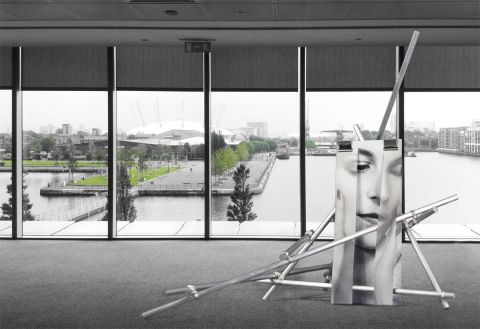I’ve just finished the second version of Not at Clifford Chance (top right), which investigates how multiple small images fair when placed on a complex scaffolding support structure.
I’ve got mixed feeling about the results. On one hand, the general approach fits well with my original vision of multiple images interrupting and disrupting each other. However the metal structure in itself makes a strong architectural statement, and in this case using it to support multiple images seems to weaken both collage and sculpture; the final results are simply too busy competing with each other. Perhaps the simplicity of version 1, where the structure supported a single collage, is as far as this marriage of two parts can go? But if so, what does the sculpture add — is the picture as effective just mounted direct onto a wall? I also question if the scaffolding is a piece in its own right, devoid of collage (bottom right)?
In the shadow of her gaze n.02 http://www.tate.org.uk/whats-on/tate-modern/exhibition/richard-hamilton?gclid=CMLNpbCW77wCFSsKwwodlpoAJw() didn’t suffer with these issues, possibly as its metal rods all reach upwards within one plane.
I visited Richard Hamilton’s (http://www.tate.org.uk/whats-on/tate-modern/exhibi…) new exhibition at Tate Modern this week with a friend. There’s a box structure in room 1, Growth and Form, 1949 – 1951, where fine metal rods delineate the planes of a cube. Perhaps re-arranging the scaffolding in a similar uniform way might deliver a more appropriate support structure? A mirrored pillar positioned in the centre of the arrangement could generate interesting reflections?
The way Hamilton handles reflection within the Tate show is interesting. At some points they’re true — real mirrored pillars in the middle of a room, dividing the frame, pulling viewer and works behind them into the picture. At other times they’re virtual; painted into pictures in an ambiguous way that make it difficult to tell if Hamilton is depicting real space or reflection.
I’m finding reflection everywhere at the moment…or perhaps this mirrors my current state of obsession?!
Three things to test:
This version of scaffolding accompanied by a simple collage
One collage directly mounted onto a wall
Scaffolding, cubed








